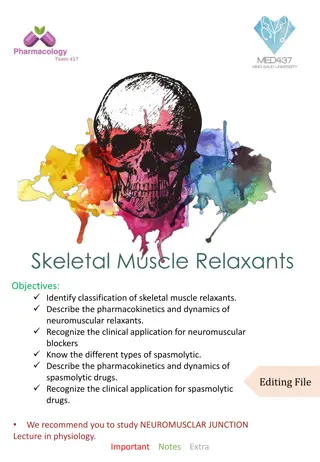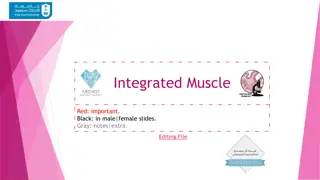Overview of Skeletal Muscle Relaxants and Neuromuscular Blockers
Skeletal muscle relaxants and neuromuscular blockers are important drugs used to induce muscle relaxation. They are classified based on their site of action and mechanism of action. Understanding their classification, pharmacokinetics, and clinical applications is crucial for medical professionals. Learn more about these medications in this comprehensive lecture.
- Skeletal Muscle Relaxants
- Neuromuscular Blockers
- Pharmacokinetics
- Clinical Applications
- Drug Classification
Download Presentation

Please find below an Image/Link to download the presentation.
The content on the website is provided AS IS for your information and personal use only. It may not be sold, licensed, or shared on other websites without obtaining consent from the author. Download presentation by click this link. If you encounter any issues during the download, it is possible that the publisher has removed the file from their server.
E N D
Presentation Transcript
Muscle Relaxants Important Main text Male slide Female slide Extra info Doctor notes EDITING FILE EDITING FILE
Learning Objectives By the end of this lecture, students should be able to: Identify classification of skeletal muscle relaxants. Describe the pharmacokinetics and dynamics of neuromuscular relaxants. Recognize the clinical applications for neuromuscular blockers. Know the different types of spasmolytics. Describe the pharmacokinetics and dynamics of spasmolytic drugs. Recognize the clinical applications for spasmolytic drugs.
Skeletal muscle relaxants (SKM relaxants): Are drugs used to induce skeletal muscle relaxation. Classification of SKM relaxants (Classified according to side of action) Peripherally acting Direct acting Centrally acting (Acts on neuromuscular junction) (Directly acting on muscle fibers) (Acts on CNS) e.g. 1. Baclofen 2. Diazepam e.g. 1. Dantrolene
Neuromuscular Blockers Classification (Peripherally acting) Competitive (non depolarizing blockers) Depolarizing blockers (non competitive) E.g. E.g. Depolarizing muscle relaxants act as acetylcholine (ACh) receptor agonists, whereas nondepolarizing muscle relaxants function as competitive antagonists. d-tubocurarine (prototype) Atracurium Mivacurium Pancuronium Vecuronium Rocuronium Succinylcholine
Peripheral acting SKM Relaxants (neuromuscular blockers) Neuromuscular blockers Act by blocking neuromuscular junction or motor end plate leading to Skeletal muscle relaxation. Important Mechanism of action Are competitive antagonists for Ach at the nicotinic receptors present in post junctional membrane of neuromuscular junction or motor end plate. No depolarization of post junctional membrane (non depolarizing). Action can be reversed by increasing by cholinesterase inhibitors (neostigmine) which increase Ach concentration at motor end plate. Acetylcholinesterase (AchE) breaks down or hydrolyzes Ach, so AchE inhibitors will increase Ach concentration. Peripherally acting Competitive blocker (non depolarising) Long action: Intermediate action -Atracurium -Vecuronium -Rocuronium Short acting: -Mivacurium -D-tubocurarine (prototype). First muscle relaxant used clinically -Pancuronium Drugs If the drug ended with curium or curonium it means that it is a SKM relaxant acting peripherally and mainly competitive
They are polar compounds. Inactive orally & taken parenterally. Do not cross BBB (no central action). Do not cross placenta. (can be used for pregnant women) Metabolism depend upon kidney or liver. EXCEPT: Mivacurium (degraded by acetyl cholinesterase). Atracurium (spontaneous degradation in blood). Pharmaco- kinetics Peripherally acting Competitive blocker (non depolarising) Skeletal muscle relaxation (Small rapidly contracting muscles of face, eyes ,fingers ,neck ,trunk muscle ,intercostal muscles,diaphragm). Recovery comes from REVERSE MANNER starting with diaphragm, Last is face and eyes. They produce different effects on CVS (cardiovascular system). Some release histamine and produce hypotension. d-Tubocurarine (sever release of histamine) Atracurium Mivacurium Others produce tachycardia (Increase Heart rate) Pancuronium Pharmaco- Logical action
Mechanism of action of neuromuscular blockers (extra explanation) Normally in the neuromuscular junction, the acetylcholine will attach with the acetylcholine receptors (in skeletal muscle the receptors) are nicotinic receptors type 1 after that a lot of changes will happen so that the muscle contracts. However, the Neuromuscular blockers will block the nicotinic receptors so acetylcholine cannot bind with the receptors, thus, preventing its action (muscle contraction) and if the muscle won t contract it ll relax Thanks to Team441
Neuromuscular junction In boys slide helpful video: (mnemonic for non depolarizing NMBs)
1-2 Hours ( long duration ) Duration (if the excretion mainly in the Kidney( high percentage) this means long duration of action). All of them have relatively short half life Metabolism and excretion Eliminated by kidney 60% - 40% liver 1-D-Tubocurarine Histamine releaser leading to: 1. Bronchospasm (constriction of bronchial smooth muscles) 2. Hypotension (Blocks autonomic ganglia) 3. Tachycardia Side effects Not used clinically due to adverse effects. (side effects) Uses Contraindication (not good for) Potency More safer derivatives are now available to be used in clinical settings. Notes
Duration 30 min (intermediate duration) Metabolism and excretion Eliminated by non enzymatic chemical degradation in plasma (spontaneous hydrolysis at body pH) no enzymes involved Side effects Transient hypotension (due to histamine release), bronchospasm. 2- Atracurium Uses Used in liver failure and kidney failure (drug of choice) Contraindication (not good for) Asthmatic patients because it releases histamine leading to bronchospasm Potency As potent as curare (1.5) Anti-histamine pretreatment may prevent these side effects. No effect on muscarinic receptor nor ganglia. Notes
Duration 15 min (The shortest duration) of all competitive neuromuscular blockers. Metabolism and excretion Fast onset of action Metabolized by pseudo cholinesterases. Dr s note: Enzyme present in plasma that breaks down any ester Side effects Transient hypotension (due to histamine release). 3-Mivacurium Used with liver or kidney failure patients. (Mivacurium & Atracurium don't depend on the kidney or liver for metabolism. Remember?) Uses Longer duration in patient with liver disease (enzymes come from the liver, so liver diseases will prevent forming the enzyme that metabolize this drug) or genetic cholinesterase deficiency or malnutrition (lead to protein deficiency which is important to form enzymes) Contraindicatio n (not good for) Important Chemically related to atracurium Mivacuriuam induced prolonged muscle paralysis. can be reversed by acetycholinesterase inhibitors such as endrophonium. acetycholinesterase inhibitors increase the Ach level in NMJ and displace Mivacuriam from nicotinic receptors in NMJ. Notes
Duration Long duration of action (metabolic products have some NM blocking activities) Metabolism and excretion Metabolized in liver and excretion by the kidney(80%) (renal) Hypertension, tachycardia. Increase norepinephrine release from adrenergic nerve endings. Antimuscarinic action (block parasympathetic action, atropine-like action) Blocks muscarinic receptor in SA sinoatrial node. 4- Pancuronium Side effects Uses - Contraindication (Not good for) Patient with coronary diseases Potency More potent than curare (6 times) Notes -
Duration Intermediate duration Metabolism and excretion Metabolized mainly by liver. Excretion mainly in bile. No histamine release. No tachycardia. No atropine like actions. (No antimuscarinic action) No ganglion block. 5- Vecuronium Advantages Good for patients with renal failure because its excreted by the bile good for cardiac patients because it has no antimuscarinic effect (no release of norepinephrine therefore no tachycardia) Team439 Uses Liver failure patients since its metabolised by the liver and excreted in the bile Contraindication (not good for) Potency More potent than tubocurarine ( 6 times ).
Duration intermediate duration ONLY IN GIRL SLIDES Metabolism and excretion Biliary excretion No histamine release. No tachycardia. No vagal blockade (No atropine like actions) Advantages 6- Rocuronium Uses - Contraindication (not good for) - Potency -
Phase I: combine and active with nicotinic receptor in post-junctional membrane of neuromuscular junction initial depolarization of motor end plate muscle twitching. Phase II: Persistent depolarization Skeletal muscle relaxation paralysis (Phase II clinically resembles non-depolarizing muscle relaxants) Depolarizing Peripherally Acting Mechanism of action helpful video Drugs Succinylcholine (suxamethonium) Fast onset of action (1 min) Short duration of action (5-10 min.). Metabolized by pseudo-cholinesterase in plasma. Half life is prolonged in: Neonates (Low enzymes) Elderly (Liver function declined due to aging) Pseudo-cholinesterase deficiency (liver disease or malnutrition or genetic cholinesterase deficiency). Pharmacokinetics
Skeletal muscles: initial twitching relaxation Side effect: Hyperkalemia (due to muscle contraction): Cardiac arrest. CVS: arrhythmia Eye: intraocular pressure (due to contraction of extra-ocular muscle). Fasciculation Spastic paralysis. GIT: intragastric pressure regurgitation of gastric content to esophagus. Depolarizing Peripherally Acting Pharmacological action Glaucoma (high eye pressure ) Patient with cardiac diseases Contraindication (not good for) Hyperkalemia (elevated levels of potassium in the blood serum) CVS arrhythmia Intraocular pressure contraindicated in glaucoma Can produce malignant hyperthermia (severe muscle contraction) May cause succinylcholine apnea* due to deficiency of pseudo- cholinesterase by liver disease, Malnutrition. Organophosphorus poisoning (acetylcholinesterase inhibition).(will increase the Ach in the body) Side effects *Prolonged apnea and paralysis can occur with succinylcholine and mivacurium in case of plasma cholinestrase deficiency.
Mechanism of non-depolarizing and depolarizings muscle relaxants ONLY IN BOY SLIDES e.g Atracurium Succinycholine
What is the Mechanism of this disease? Is a rare inherited condition that occurs due to inability to bind calcium by sarcoplasmic reticulum in some patients due to genetic defect. Increase Ca release lead to: muscular rigidity(spasm),metabolic acidosis tachycardia, hyperpyrexia. (hyperthermia) Is a rare bizarre inherited condition of having body temperature greatly above normal Is an example of Idiosyncrasy* Malignant hyperthermia When did it occurs? It occurs upon administration of drugs as (Sensitive to some drugs): general anesthesia e.g. halothane neuromuscular blockers e.g. succinylcholine Treatment by : Dantrolene
Drug Duration Side Effects Note Long 1-2 h Tubocurarine Hypotension Renal failure Long 1-2 h Pancuronium Tachycardia Renal failure -Spontaneous degradation Used in liver and kidney failure Transient Atracurium Short 30 min. hypotension Histamine release Vecuronium Short 40 min. Few side effects -Liver failure -Metabolized by pseudocholinesterase - Choline esterase deficiency Similar to atracurium Mivacurium Short 15 min. -CVS Diseases -Glaucoma -Liver disease Succinyl Choline Hyperkalemia Arrhythmia Increase IOP Short 10 min.
As adjuvant in general anesthesia to induce muscle relaxation. Relieve of tetanus and epileptic( )convulsion. Facilitate endotracheal intubation. control convulsion ( ) electroshock therapy in psychotic patients. Orthopedic surgery. Uses of neuromuscular blockers Drugs: as aminoglycosides (e.g. streptomycin),magnesium sulphate( antagonize the effect of muscle relaxants), general anesthetics can potentiate or enhance the effect of neuromuscular blockers. Cholinesterase inhibitors may enhance the effect of depolarizing relaxants but decrease the effect of nondepolarizing relaxants. Diseases: Myasthenia gravis (already have muscle relaxation) and Parkinson increase the response to muscle relaxants (modify the response to muscle relaxants) Magnesium sulphate may antagonize the effect of muscle relaxants. Drugs and diseases that modify effects of neuromuscular blockers Diseases:
Muscle relaxant Action Act on Clinical uses GABA agonist - acts on spinal cord They reduce muscle spasm in spastic states produced by neurological disorders as: Spinal cord injury Cerebral stroke Cerebral palsy Multiple sclerosis Baclofen Centrally acting Centrally acting centrally or peripherally( Diazepam (Benzodiazepines) ( Facilitate GABA action on CNS Direct action on skeletal muscles. Mechanism of action: Acts directly on skeletal muscles. It inhibit excitation-contraction coupling in the muscle fiber by binding to ryanodine receptor 1. Ryanodine receptor mediate the release of calcium from sarcoplasmic reticulum, an essential step in muscle contraction. Calcium is released from the sarcoplasmic reticulum via acalcium channel, called the ryanodine receptor (RyR) channel and dantrolene blocks the opening of these channels All the above + Orally, IV, (t 1 2 = 8 - 9 h) Used in the treatment of: 1.Spastic states 2.Malignant hyperthermia Dantrolene
MCQs: 1- Which of the following competitive neuromuscular blocker metabolised by pseudo-cholinesterase? A)Rocuronium B)Mivacurium C)vecuronium D)pancuronium 2- Which of the following spasmolytics it use to treat the malignant hyperthermia? A)Dantrolene B)Baclofen C)Diazepam D)succinctlycholine 3- which one of the following more release of histamine? A)pancuronium B)Mivacurium C)Atracurium D) d Tubocurarine 4- Which of the following competitive neuromuscular blocker is spontaneous degradation in blood? A)Rocuronium B)Mivacurium C)Atracurium D)vecuronium 5- Which of the following competitive neuromuscular blocker produce tachycardia as side effect? A)Mivacurium B)d-Tubocurarine C)Atracurium D)Pancuronium 1-B 2-A 3-D 4-C 5-D
SAQ: 1- What the drug of choice (competitive neuromuscular blockers) in liver failure & kidney failure? 2-why Atracurium should be avoided in asthma? 3- Why avoid use pancuronium patient with coronary disease? 1- Atracurium 2-It cause bronchospasm due to histamine relase 3- - Hypertension, tachycardia. - Increase norepinephrine release from adrenergic nerve endings. - Antimuscarinic action (block parasympathetic action, atropine-like action).
THE LEADER OF PHARMACOLOGY AND MEMBERS Mayssam Aljaloud Reema Alhussein Rahaf Almotairi Layan Aldoukhi Farah Alfayez Reema Alquraini Alhnouf Alyami Alhatoun Alhawyan Refal Alamry Razan Almanjomi Shatha Alshabani Sara Alsuwaidan Contact us: pharmacology442@gmail.com























